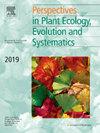Insect herbivory and leaf defensive traits in native and non-native populations of an endemic plant in a Macaronesian archipelago
IF 2.9
3区 环境科学与生态学
Q1 ECOLOGY
Perspectives in Plant Ecology Evolution and Systematics
Pub Date : 2025-06-05
DOI:10.1016/j.ppees.2025.125886
引用次数: 0
Abstract
The spread of island endemic plants to new islands is an emerging topic, yet the mechanisms driving such invasions remain unclear. While herbivory-related explanations are common for widespread species, their relevance to island endemics is uncertain. Enemy release suggests that introduced plants face less herbivory and invest less in defence, unlike at their native sites with specialized herbivores. Conversely, low defences from minimal native herbivory could make them vulnerable to generalist herbivores in new locations. Additionally, abiotic factors—such as soil type or climate—may influence plant traits and herbivore interactions, potentially overriding or complicating expected herbivory-based invasion outcomes. Here we compared in situ levels of insect leaf herbivory and leaf chemical, physical, and nutritional traits for Rumex lunaria across islands of the Canary Archipelago to which this species is endemic. Specifically, we sampled populations found on islands where this species is native (Tenerife, Gran Canaria, La Gomera, La Palma, and El Hierro) and compared them to invasive (non-native) populations found on Lanzarote. Contrary to predictions, R. lunaria found on Lanzarote (i.e., non-native populations) exhibited higher levels of herbivory but also higher defensive traits—specifically, thicker leaves and higher concentrations of phenolic compounds—compared to populations on islands where this species is native to. To explore underlying correlates to these patterns, we conducted a follow-up structural equation model testing whether abiotic variation between native and non-native populations contributes to explain differences in leaf traits and herbivory. While non-native populations were associated with distinct abiotic conditions relative to native ones—including higher temperatures, reduced and more seasonal precipitation, and denser, more alkaline soils—this did not account for observed differences in leaf traits or herbivory between native vs. non-native populations. Accordingly, these findings suggest that the divergence in leaf defences and herbivory between native and non-native R. lunaria populations is not attributable to the abiotic factors analysed.
马卡罗内西亚群岛一特有植物的本地和非本地种群的昆虫食草性和叶片防御特性
岛屿特有植物向新岛屿的传播是一个新兴的话题,但驱动这种入侵的机制尚不清楚。虽然与草食有关的解释对广泛分布的物种来说很常见,但它们与岛屿特有物种的相关性尚不确定。敌人的释放表明,引进的植物面临的食草性更少,在防御上的投入也更少,不像在它们的原生地点有专门的食草动物。相反,对原生食草动物的防御能力较低,可能会使它们在新地方容易受到多面手食草动物的攻击。此外,非生物因素,如土壤类型或气候,可能影响植物性状和草食动物的相互作用,潜在地压倒或复杂化预期的草食动物入侵结果。在这里,我们比较了该物种特有的加那利群岛各岛屿的昆虫叶片食草性和叶片化学、物理和营养性状的原位水平。具体来说,我们对该物种原生的岛屿(特内里费岛、大加那利岛、戈梅拉岛、拉帕尔马岛和耶罗岛)上发现的种群进行了采样,并将它们与兰萨罗特岛上发现的入侵(非本地)种群进行了比较。与预测相反,在兰萨罗特岛(即非本地种群)上发现的月牙藓(R. lunaria)表现出更高水平的草食性,但也表现出更高的防御特征——特别是,更厚的叶子和更高浓度的酚类化合物——与该物种原生的岛屿种群相比。为了探索这些模式的潜在相关性,我们进行了后续的结构方程模型,以检验本地和非本地种群之间的非生物变异是否有助于解释叶片性状和食草性的差异。虽然与本地种群相比,非本地种群与不同的非生物条件有关——包括更高的温度,减少和更多的季节性降水,以及更密集、更碱性的土壤——但这并不能解释在本地种群与非本地种群之间观察到的叶片性状或食草性的差异。因此,这些研究结果表明,本地和非本地月牙莲种群在叶片防御和食草性方面的差异不是由所分析的非生物因素引起的。
本文章由计算机程序翻译,如有差异,请以英文原文为准。
求助全文
约1分钟内获得全文
求助全文
来源期刊
CiteScore
6.50
自引率
0.00%
发文量
28
审稿时长
67 days
期刊介绍:
Perspectives in Plant Ecology, Evolution and Systematics (PPEES) publishes outstanding and thought-provoking articles of general interest to an international readership in the fields of plant ecology, evolution and systematics. Of particular interest are longer, in-depth articles that provide a broad understanding of key topics in the field. There are six issues per year.
The following types of article will be considered:
Full length reviews
Essay reviews
Longer research articles
Meta-analyses
Foundational methodological or empirical papers from large consortia or long-term ecological research sites (LTER).

 求助内容:
求助内容: 应助结果提醒方式:
应助结果提醒方式:


